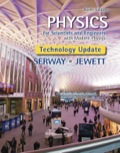
The frequency will the AC source deliver a power of 250 W
Answer to Problem 33.81CP
Explanation of Solution
Given info: The rms potential difference of an AC source is
Formula to calculate the rms current in the circuit is,
Here,
Write the expression for the power deliver to the circuit.
Substitute
Rearrange the equation for
Formula to calculate the impedance of the circuit is,
Here,
Substitute
Substitute
Assume
Substitute
Substitute
Simplify the equation more,
Solve for first equation,
Since the angular frequency is a positive quantity. So, equation can be rewrite as,
Solve the quadratic equation.
Substitute
Formula to calculate the frequency is,
Substitute
Solve for second equation,
Since the angular frequency is a positive quantity. So, equation can be rewrite as,
Solve the quadratic equation.
Substitute
Formula to calculate the frequency is,
Substitute
Since the value of frequency comes out to be two that means the circuit deliver the given power two times one is below resonance and another one is above resonance.
Conclusion:
Therefore, there are two values of frequencies at which the AC source deliver a power of
Want to see more full solutions like this?
Chapter 33 Solutions
EBK PHYSICS FOR SCIENTISTS AND ENGINEER
- Lab 8 Part 3 PHET Wave Interface simulation. I am having trouble with this part of the lab.arrow_forwardMick and Rick are twins born on Earth in the year 2175. Rick grows up to be an Earth-bound robotics technician while Mick becomes an intergalactic astronaut. Mick leaves the Earth on his first space mission in the year 2200 and travels, according to his clock, for 10 years at a speed of 0.75c. Unfortunately, at this point in his journey, the structure of his ship undergoes mechanical breakdown and the ship explodes. How old is Rick when his brother dies?arrow_forwardHi, I have canceled, why did you charge me again?arrow_forward
 Physics for Scientists and EngineersPhysicsISBN:9781337553278Author:Raymond A. Serway, John W. JewettPublisher:Cengage Learning
Physics for Scientists and EngineersPhysicsISBN:9781337553278Author:Raymond A. Serway, John W. JewettPublisher:Cengage Learning Physics for Scientists and Engineers with Modern ...PhysicsISBN:9781337553292Author:Raymond A. Serway, John W. JewettPublisher:Cengage Learning
Physics for Scientists and Engineers with Modern ...PhysicsISBN:9781337553292Author:Raymond A. Serway, John W. JewettPublisher:Cengage Learning Physics for Scientists and Engineers: Foundations...PhysicsISBN:9781133939146Author:Katz, Debora M.Publisher:Cengage Learning
Physics for Scientists and Engineers: Foundations...PhysicsISBN:9781133939146Author:Katz, Debora M.Publisher:Cengage Learning College PhysicsPhysicsISBN:9781938168000Author:Paul Peter Urone, Roger HinrichsPublisher:OpenStax College
College PhysicsPhysicsISBN:9781938168000Author:Paul Peter Urone, Roger HinrichsPublisher:OpenStax College College PhysicsPhysicsISBN:9781305952300Author:Raymond A. Serway, Chris VuillePublisher:Cengage Learning
College PhysicsPhysicsISBN:9781305952300Author:Raymond A. Serway, Chris VuillePublisher:Cengage Learning Glencoe Physics: Principles and Problems, Student...PhysicsISBN:9780078807213Author:Paul W. ZitzewitzPublisher:Glencoe/McGraw-Hill
Glencoe Physics: Principles and Problems, Student...PhysicsISBN:9780078807213Author:Paul W. ZitzewitzPublisher:Glencoe/McGraw-Hill





